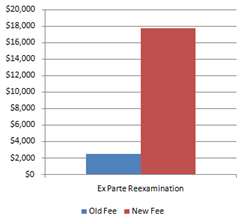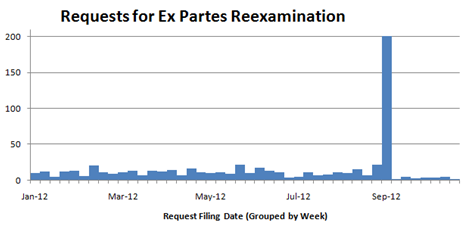
Historically about two thirds of ex parte reexaminations were filed by third-party filers. In recent years, that figure has risen so that now around 90% of ex parte reexamination requests are filed by third-parties. The America Invents Act of 2011 (AIA) made only a very limited change to the ex parte reexamination structure. The greatest change, however, came about on September 16, 2012 when the USPTO instituted a new fee regime that boosted the cost of ex parte reexaminations from $2,520 to $17,750.
In the days leading up to September 16, 2012 there was a rush to file these ex parte reexamination requests in order to beat the fee deadline. The 200 or so requests filed in the final week is equivalent to about four months of filing in more ordinary weeks. With that in mind, it is not surprising that the post-September-16 filings are at a much lower rate – about one third of the pre-implementation rate for the past seven weeks.

By new year (January 2013), any gap created by the rush to file should be dissipated. However, I don’t expect for the ex parte reexamination filings to be back to their normal pre-AIA rate because of the new high-cost of filing ex parte reexaminations and because supplemental examination is now a better alternative for the majority would-be owner-filed reexaminations. The one caveat is that the new increased expense of inter partes review may push some challengers toward the ex parte approach.
Notes
- Upcoming – A review of recently filed supplemental examination requests.
- If you are worried that the drop in filing post-implementation will harm the USPTO’s bottom line, don’t worry. The PTO’s CFO should see the raise in fees as a very good business move. The PTO now has two thirds less work coming-in but each bit of work receives seven times more revenue. More money for less work is never a bad thing (unless you are the customer).
- Eight Points about September 16, 2012
- A Rush to File at the End of Inter Partes Reexaminations
Once again, I agree.
Mere non disclosure no longer is IC, even of a reference that is anticipatory.
As patent owners can choose to sue only on valid, dependent claims, there should be no need for many patent owners to voluntarily expose his patent to any reexamination.
A narrowing reissue remains a lower-cost alternative for errors that have to be fixed.
Where does that leave us? Most reexaminations still will be ex parte and filed by accused infringers primarily to force amendments as a proximate result of the PTO’s use of BRI. Amendments may have the effect of eliminating past damages and may well be worth the expense to an accused infringer.
If the Federal Circuit takes the issue of BRI en banc, even BRI may be gone, thus reducing the incentives for filing ex parte even more.
To further discuss flaws in PTO usage projections, ex parte reexaminations can be requested by the patent owner but are vastly more commonly requested by any motivated third party, and can even be requested anonymously. But the new supplimental examinations can only be requested by the patent owner and are just for the issues raised by the patent owner. Whilesupplimental examinations are not limited to only patents and publications, they will only protect against later inequitable conduct acusations for claims re-allowed over just the issues submitted by the patent owner, not any other issues, and not any new IC issues that may be caused by declarations filed by the patent owner in getting claims re-allowed in the supplimental reexamination. Given the 2011 en banc Therasense decision of the CAFC greatly reducing IC threats, the likelyhood of large numbers of supplimental reexamination filings is highly dubious.
I can cope quite well thank you – your questioniing of my understanding of “aggregate” is what is cryptic, as is how you do not understand what I am plainly (and clearly) saying. The piece parts must come together to meet the budget. If the piece parts are way off – and each of them are way off inthe wrong direction, there is no way for the aggregate to be met.
Methinks you are responding to the messenger, and not the message. Either that, or you missed having the Calvinball spiked in your face.
Sorry IANAE, your post is just too cryptic.
Sorry, it was meant for native English speakers.
Here’s a translation you might be able to cope with: “You clearly don’t know what the word ‘aggregate’ means.”
Sorry IANAE, your post is just too cryptic.
if the piece parts are individually (and uncontrollably) way off, how is the Office said to be following its mandated limitation to have the aggregate balanced to the budget?
Because words mean things, no matter how hard you fight them.
“over the past few years” should read “in comparison to the past few years”
Thank you Prof. Crouch.
I recognize the concern in that the Office was appraised of being off and did not change enough to reflect the input.
Without denigrating your view, it is entirely plausible that the Office can make a “colorable” argument that the level of fees meets the policy – as the Office sees its estimates as somehow being defensible (personally, I am with you and Paul on this – the math simply does not add up under any stretch of the imagination).
However, my point still applies – the Office was given this new fee-setting power, but that power came with a stipulation (the aggregate balance).
What happens if that stipulation is not met?
The power given is a bit incomplete in this regard. Rather, the check on that power is incomplete. What is there to hold an administrative agency to the law in this important regard? Note too, that this is not the only facet of the hike in fees that seems to fail the aggregate balancing. The hike in fees across the board, both in prosecution AND in maintenance is troubling. Previously, prosecution costs were held artificially low and “made up” with higher than cost maintenance fees. Yet, now, prosecution costs are hiked (ostensibly to cover costs) AND maintenance fees are hiked (now even more out of line with costs).
Given that there is no actual guarantee that fees collected will stay in the patent office, I fear that the innovation tax will actually worsen over the past few years. In opposition to Paul’s point about “public costs,” this is a boondoggle for the public in the making (at least that part of the public outside the innovation community that is paying in to subsidize the tax base that user fees are going to).
… or be prepared to abandon the patent if they do!
Apart from the difference in issues that may be raised, the result of a Supplemental Examination is for the PTO to decide whether or not to start an Ex Parte Reexam, albeit for $16k+ rather than $17k+, and upon the same issues as the Supplemental Exam, not those of a regular Ex Parte Reexam.
This means, amongst other things, that there is no cost saving associated with a Supplemental Exam UNLESS you can convince the PTO not to go ahead with a Reexam.
Dennis, regarding contested proceedings, as I mentioned before, litigators do not like short proceedings that resolve the issues quickly and decisively. Not at all. I daresay, the only reason a litigator would recommend filing in the PTO is to avoid a jury for some reason.
Regarding ex parte, the high fees WILL keep the under-financed do-gooders at bay. But is necessarily a bad thing for the country? The well-healed will hardly notice the fees, unless they are going to challenge a lot of patents out of kindness of their hearts…. Yeah, sure.
Remember, the primary objective of ex parte, for accused infringers anyway, is to force amendments to get rid of past damages, to harrass the patent owner, to delay his licensing program, and to maximize his expenses through serial reexaminations. Public interest is not the objective. It is the result, if anything, of private action for private reasons.
I personally believe that, from a policy perspective, that the PTAB/CRU fees are set too high and will discourage the filing of administrative processes that would help clear up the scope of patent coverage for important patents.
In this bit of the conversation, however, I think that our concern is that that the PTO suggested that thousands of these cases would be filed each year. At the time, the PTO was told that their estimate was incorrect and the initial reports are that their estimate was incorrect.
Paul and I have already traded comments on the “PTAB,” fees, and resources related to fees, but an interesting limitation to Office fee setting authority is the requirement that fees must still balance out in the aggregate to the budget.
Food for thought: if the piece parts are individually (and uncontrollably) way off, how is the Office said to be following its mandated limitation to have the aggregate balanced to the budget? And perhaps more importantly, what is the penalty for violating this limitation?
Lets hope that its analysis regarding PTAB/CRU filings are not indicative of the PTO’s ability to think through regulatory models — especially as the PTO increases its regulatory authority and swagger in the AIA implementation process.
The blog “Inventive Step” says:
“During FY2011, the PTO received 758 requests for ex parte reexamination where [only] 104 were filed by the patent owner.
Thus, the PTO estimates it will receive about 800 such requests in the years going forward, with those filed by the patent owner now being requests for supplemental examination.
The PTO expects that most requests for supplemental examination will be to correct allegations of inequitable conduct. About 2,900-3,300 patent cases have been filed each year in district courts for the past 5 years. Inequitable conduct is pled in about 40% of the cases. Thus, the PTO estimates about 1,430 requests for supplemental examination to be filed annually, with approximately 500 being filed by small entities.”
[I would love to accept a wager that these alleged PTO projections will be wildly, grossly, innacurate.]
I will say that, at a minimum, my chart is more informative than many patent figures.
The differentiating colors were important too
I like how you made a chart of the old fee vs new fee in case anyone couldn’t tell what the difference between the two numbers was.
Kip – my understanding is that the PTO is not going to raise 101 or 112 issues of patentability regarding existing claims unless those issues are raised by the patent owner in the supplemental examination request.
Dennis, wouldn’t patent owners want to file ex parte, instead of supplemental ex, if they want to avoid 101 and 112 challenges? It seems to me that a large number of patent owners would want to do so, even if they are concerned about overcoming some prior art.
Comments are closed.